Markov-Modulated and Shifted Wishart Processes with Applications in Derivatives Pricing
Abstract
1. Introduction
- We introduce two new stochastic covariance models, the MMSW and the SW process, both extensions of the Wishart process. The need for the shifts, both constant (SW) or Markov modulated (MMSW), is motivated empirically by nonzero lower bounds for variances and changes in volatility and correlations during crises, respectively.
- Key properties of these new processes are demonstrated; in particular, several characteristic functions of interest and the long-term dynamics are obtained in closed form.
- The CGMM methodology is implemented on two pairs of asset prices, the S&P500 and AAPL symbols, and GOOG and INTC symbols, to produce estimates for the parameters of the Wishart process and the MMSW.
- The Fourier transform method is used, together with the characteristic function (c.f.), to price Spread Options. The accuracy of the c.f. and derivatives prices is confirmed via Monte Carlo simulations. The importance of accounting for crises in the spread options pricing is documented, revealing an impact of up to when the models are calibrated to the same data.
2. Models and Properties
2.1. The SW Process: Wishart Process with Constant Shift
2.2. The MMSW Process: Wishart Process with Markov-Modulated Shift
3. Empirical Analysis, Estimation
3.1. Estimation Methodology
3.2. Parameter Estimates
4. Results and Discussion on Derivative Pricing
4.1. Fast Fourier Approach
4.2. Models vs. Monte Carlo Simulation
4.3. Comparison of Models
5. Conclusions and Future Research
Author Contributions
Funding
Institutional Review Board Statement
Informed Consent Statement
Data Availability Statement
Conflicts of Interest
Appendix A
Appendix A.1. Proof of Proposition 3
Appendix A.2. Proof of Proposition 4
Appendix A.3. Proof of Proposition 6
Appendix A.4. Proof of Proposition 8
Appendix A.5. Option Pricing Under Risk Neutral Measure
| Option | K | Source of Price | Wishart | Shifted W. | MMSW |
|---|---|---|---|---|---|
| Formula | 0.7248 | 0.7365 | 0.7472 | ||
| In The Money | 0.5 | Monte Carlo | 0.7191 | 0.7550 | 0.7491 |
| MC 95% lower bound | 0.7036 | 0.6996 | 0.7289 | ||
| MC 95% upper bound | 0.7424 | 0.7386 | 0.7694 | ||
| Formula | 0.4233 | 0.4251 | 0.4350 | ||
| At The Money | 1 | Monte Carlo | 0.4123 | 0.4127 | 0.4405 |
| MC 95% lower bound | 0.3971 | 0.3974 | 0.4244 | ||
| MC 95% upper bound | 0.4276 | 0.4280 | 0.4565 | ||
| Formula | 0.2040 | 0.2056 | 0.2115 | ||
| Out of The Money | 1.5 | Monte Carlo | 0.1972 | 0.1996 | 0.2197 |
| MC 95% lower bound | 0.1865 | 0.1889 | 0.2082 | ||
| MC 95% upper bound | 0.2079 | 0.2102 | 0.2312 |
| Option | K | Source of Price | Wishart | Shifted W. | MMSW |
|---|---|---|---|---|---|
| Formula | 0.8870 | 0.8892 | 0.8928 | ||
| In The Money | 0.5 | Monte Carlo | 0.8677 | 0.8921 | 0.8794 |
| MC 95% lower bound | 0.8385 | 0.8623 | 0.8500 | ||
| MC 95% upper bound | 0.8970 | 0.9219 | 0.9088 | ||
| Formula | 0.6105 | 0.6129 | 0.6164 | ||
| At The Money | 1 | Monte Carlo | 0.5934 | 0.6134 | 0.6040 |
| MC 95% lower bound | 0.5684 | 0.5878 | 0.5788 | ||
| MC 95% upper bound | 0.6185 | 0.6391 | 0.6292 | ||
| Formula | 0.3994 | 0.4018 | 0.4045 | ||
| Out of The Money | 1.5 | Monte Carlo | 0.3852 | 0.4004 | 0.3944 |
| MC 95% lower bound | 0.3645 | 0.3791 | 0.3736 | ||
| MC 95% upper bound | 0.4059 | 0.4218 | 0.4151 |
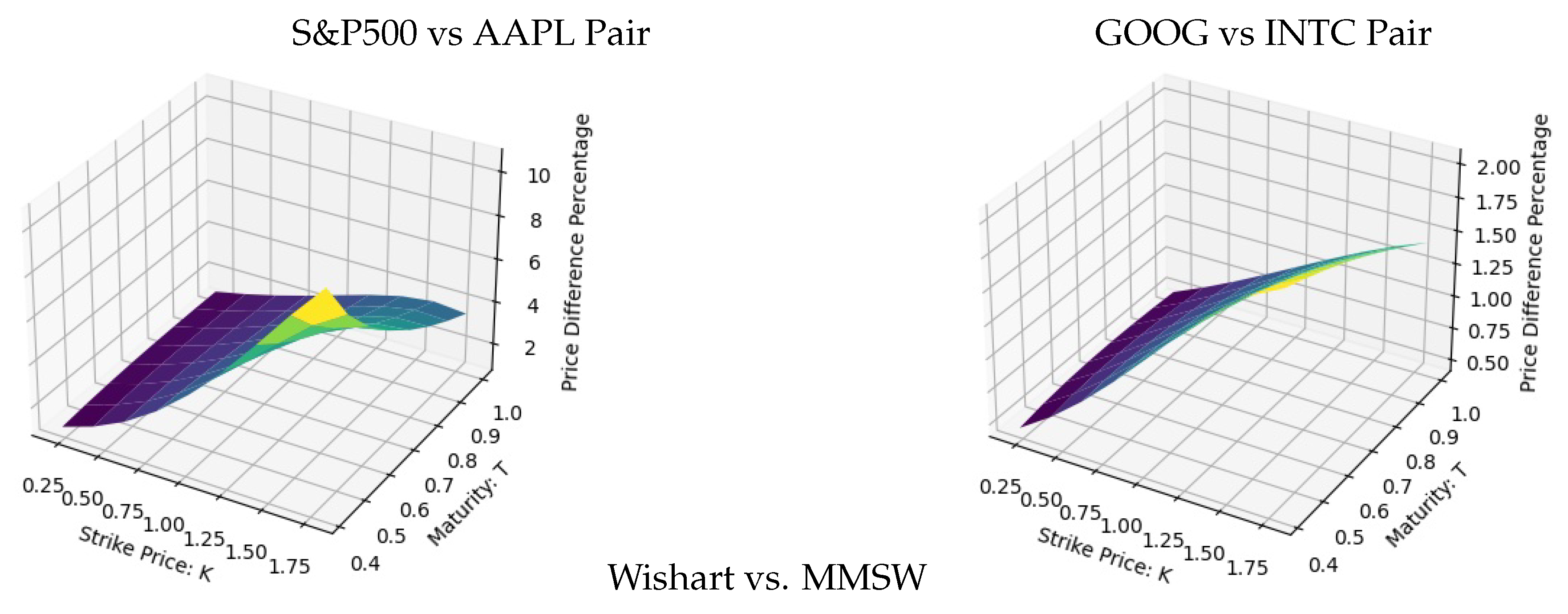

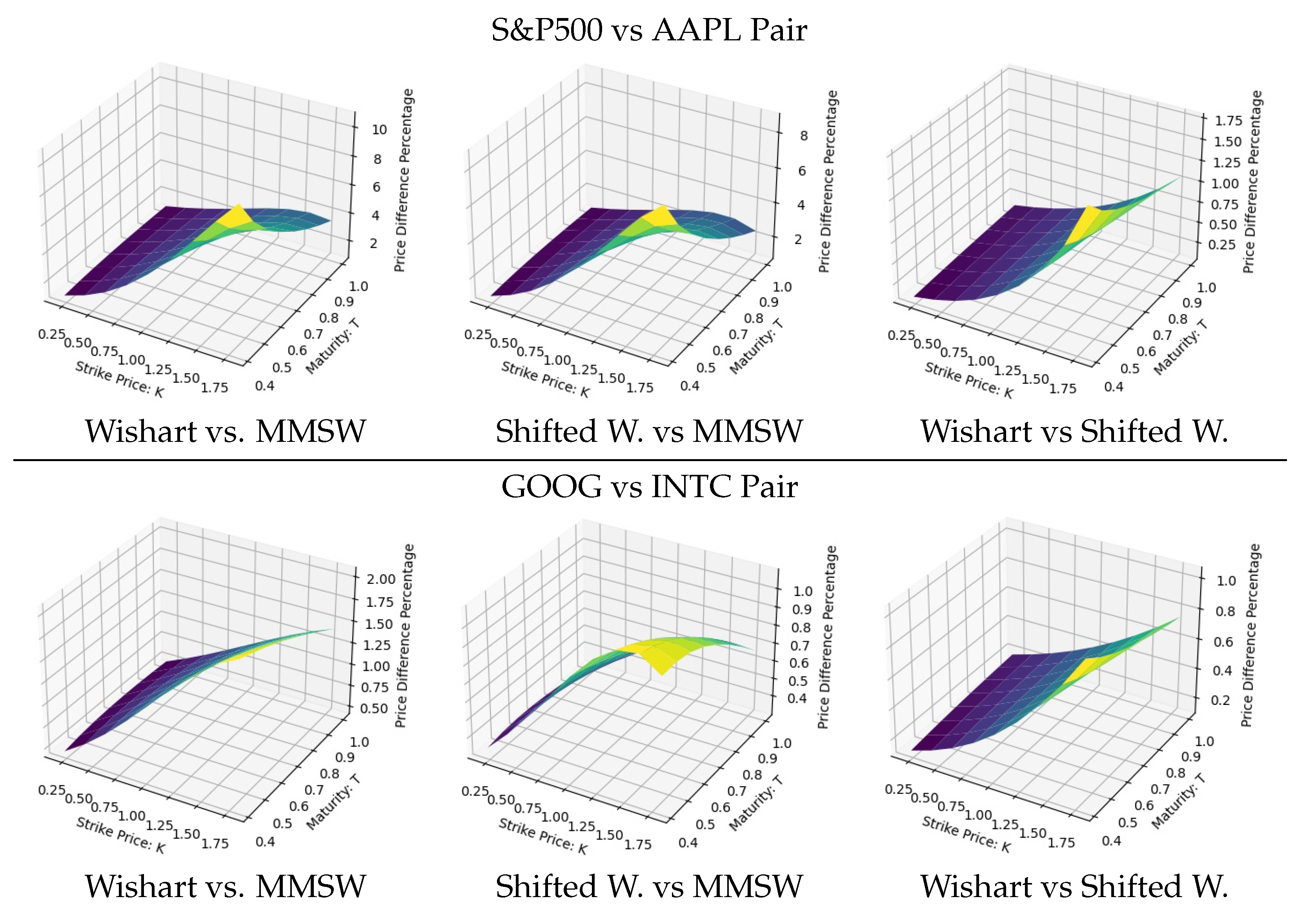
| 1 | Some authors, to ensure other statistical properties of the process, assume M symmetric and Q positive-definite and symmetric. |
| 2 | For a positive-definite matrix A, it’s square-root is a matrix B, such that . Then B will be symmetric and positive-definite, too. |
| 3 | Other alternatives for the shifts are viable with different motivations. For instance, we could shift between two independent Wishart covariances with the consequent increase in the parametric space; see Christoffersen et al. (2009), for a similar factor model for Heston. |
| 4 | As mentioned before, other alternatives for Markov-modulated extension of the Wishart process are viable. For example, a switch between two independent Wishart covariances. |
| 5 | We could have considered the market price of risk in a more general form: |
| 6 | As subtraction of positive-definite is not necessarily positive-definite, we take this into account as a constraint when searching for the optimal parameters . |
| 7 | We do not conduct a sensitivity of option prices to parameters due to its artificial nature; such analysis would only demonstrate a larger difference between MMSW, or even SW, and the embedded Wishart. |
| 8 | In the proof of this proposition, the leverage effect is hidden in terms and . |
References
- Abi Jaber, E. (2022). The Laplace transform of the integrated Volterra Wishart process. Mathematical Finance, 32(1), 309–348. [Google Scholar] [CrossRef]
- Ahdida, A., & Alfonsi, A. (2013). Exact and high-order discretization schemes for Wishart processes and their affine extensions. Annals of Applied Probability, 23(3), 1025–1073. [Google Scholar] [CrossRef]
- Andersen, T. G., Bollerslev, T., Diebold, F. X., & Labys, P. (2003). Modeling and forecasting realized volatility. Econometrica, 71(2), 579–625. [Google Scholar] [CrossRef]
- Antonov, A., Arneguy, M., & Audet, N. (2008). Markovian projection to a displaced volatility Heston model. Available online: https://papers.ssrn.com/sol3/papers.cfm?abstract_id=1106223 (accessed on 1 January 2024). Available online.
- Antonov, A., Misirpashaev, T., & Piterbarg, V. (2007). Markovian projection onto a Heston model. Available online: https://papers.ssrn.com/sol3/papers.cfm?abstract_id=997001 (accessed on 1 January 2024). Available online.
- Arian, H. (2012). Financial engineering of the stochastic correlation in credit risk models. [Unpublished doctoral dissertation]. University of Toronto.
- Bernhart, G., Höcht, S., Neugebauer, M., Neumann, M., & Zagst, R. (2011). Asset correlations in turbulent markets and the impact of different regimes on asset management. Asia-Pacific Journal of Operational Research, 28(1), 1–23. [Google Scholar] [CrossRef]
- Branger, N., Muck, M., Seifried, F. T., & Weisheit, S. (2017). Optimal portfolios when variances and covariances can jump. Journal of Economic Dynamics and Control, 85, 59–89. [Google Scholar] [CrossRef]
- Brigo, D., & Alfonsi, A. (2005). Credit default swap calibration and derivatives pricing with the SSRD stochastic intensity model. Finance and Stochastics, 9(1), 29–42. [Google Scholar] [CrossRef]
- Brigo, D., & Mercurio, F. (2001). A deterministic–shift extension of analytically–tractable and time-homogeneous short–rate models. Finance and Stochastics, 5(3), 369–387. [Google Scholar] [CrossRef]
- Bru, M.-F. (1991). Wishart processes. Journal of Theoretical Probability, 4(4), 725–751. [Google Scholar] [CrossRef]
- Buraschi, A., Porchia, P., & Trojani, F. (2010). Correlation risk and optimal portfolio choice. The Journal of Finance, 65(1), 393–420. [Google Scholar] [CrossRef]
- Carr, P., & Madan, D. (1999). Option valuation using the fast Fourier transform. Journal of Computational Finance, 2(4), 61–73. [Google Scholar] [CrossRef]
- Carrasco, M., Chernov, M., Florens, J.-P., & Ghysels, E. (2007). Efficient estimation of general dynamic models with a continuum of moment conditions. Journal of Econometrics, 140(2), 529–573. [Google Scholar] [CrossRef]
- Carrasco, M., & Florens, J.-P. (2000). Generalization of GMM to a continuum of moment conditions. Econometric Theory, 16(6), 797–834. [Google Scholar] [CrossRef]
- Chiarella, C., Hsiao, C.-Y., & To, T.-D. (2016). Stochastic correlation and risk premia in term structure models. Journal of Empirical Finance, 37, 59–78. [Google Scholar] [CrossRef]
- Christoffersen, P., Heston, S., & Jacobs, K. (2009). The shape and term structure of the index option smirk: Why multifactor stochastic volatility models work so well. Management Science, 55(12), 1914–1932. [Google Scholar] [CrossRef]
- Da Fonseca, J. (2024). Pricing guaranteed annuity options in a linear-rational Wishart mortality model. Insurance: Mathematics and Economics, 115, 112–131. [Google Scholar] [CrossRef]
- Da Fonseca, J., Grasselli, M., & Ielpo, F. (2011). Hedging (co) variance risk with variance swaps. International Journal of Theoretical and Applied Finance, 14(6), 899–943. [Google Scholar] [CrossRef]
- Da Fonseca, J., Grasselli, M., & Ielpo, F. (2014). Estimating the Wishart affine stochastic correlation model using the empirical characteristic function. Studies in Nonlinear Dynamics & Econometrics, 18(3), 253–289. [Google Scholar]
- Da Fonseca, J., Grasselli, M., & Tebaldi, C. (2007). Option pricing when correlations are stochastic: An analytical framework. Review of Derivatives Research, 10(2), 151–180. [Google Scholar] [CrossRef]
- Da Fonseca, J., Grasselli, M., & Tebaldi, C. (2008). A multifactor volatility Heston model. Quantitative Finance, 8(6), 591–604. [Google Scholar] [CrossRef]
- Deng, G., & Liu, S. (2024). Forward starting options pricing under a regime-switching jump-diffusion model with Wishart stochastic volatility and stochastic interest rate. International Journal of Computer Mathematics, 101(3), 331–356. [Google Scholar] [CrossRef]
- Duffie, D., Filipovic, D., & Schachermayer, W. (2002). Affine processes and application in finance (Tech. Rep.). National Bureau of Economic Research. [Google Scholar]
- Duffie, D., Pan, J., & Singleton, K. (2000). Transform analysis and asset pricing for affine jump-diffusions. Econometrica, 68(6), 1343–1376. [Google Scholar] [CrossRef]
- Elliott, R. J., & Nishide, K. (2014). Pricing of discount bonds with a Markov switching regime. Annals of Finance, 10(3), 509–522. [Google Scholar] [CrossRef]
- Escobar, M., Arian, H., & Seco, L. (2012). CreditGrades framework within stochastic covariance models. Journal of Mathematical Finance, 2(4), 303. [Google Scholar] [CrossRef]
- Escobar, M., Neykova, D., & Zagst, R. (2015). Portfolio optimization in affine models with Markov switching. International Journal of Theoretical and Applied Finance, 18(5), 1550030. [Google Scholar] [CrossRef]
- Escobar, M., Rudolph, B., & Zagst, R. (2016). Algorithm 963: Estimation of stochastic covariance models using a continuum of moment conditions. ACM Transactions on Mathematical Software (TOMS), 42(4), 33. [Google Scholar]
- Gorovoi, V., & Linetsky, V. (2004). Black’s model of interest rates as options, eigenfunction expansions and Japanese interest rates. Mathematical Finance: An International Journal of Mathematics, Statistics and Financial Economics, 14(1), 49–78. [Google Scholar] [CrossRef]
- Gourieroux, C. (2005). Wishart autoregressive model for stochastic risk. INSEE. [Google Scholar]
- Gouriéroux, C., & Sufana, R. (2004). Derivative pricing with multivariate stochastic volatility: Application to credit risk. Center for Research in Economics and Statistics. [Google Scholar]
- Graczyk, P., Małecki, J., & Mayerhofer, E. (2018). A characterization of Wishart processes and Wishart distributions. Stochastic Processes and their Applications, 128(4), 1386–1404. [Google Scholar] [CrossRef]
- Gribisch, B. (2016). Multivariate Wishart stochastic volatility and changes in regime. AStA Advances in Statistical Analysis, 100, 443–473. [Google Scholar] [CrossRef]
- Hamilton, J. D. (1989). A new approach to the economic analysis of nonstationary time series and the business cycle. Econometrica: Journal of the Econometric Society, 357–384. [Google Scholar] [CrossRef]
- Heston, S. L. (1993). A closed-form solution for options with stochastic volatility with applications to bond and currency options. The Review of Financial Studies, 6(2), 327–343. [Google Scholar] [CrossRef]
- Hurd, T. R., & Zhou, Z. (2010). A Fourier transform method for spread option pricing. SIAM Journal on Financial Mathematics, 1(1), 142–157. [Google Scholar] [CrossRef]
- Konikov, M., & Madan, D. B. (2002). Option pricing using variance gamma Markov chains. Review of Derivatives Research, 5(1), 81–115. [Google Scholar] [CrossRef]
- La Bua, G., & Marazzino, D. (2021). On the Application of Wishart process to the pricing of equity derivatives: The multi-asset case. Computational Management Science, 18, 149–176. [Google Scholar] [CrossRef]
- La Bua, G., & Marazzino, D. (2022). A new class of multidimensional Wishart-based hybrid models. Decisions in Economics and Finance, 45(1), 209–239. [Google Scholar] [CrossRef]
- Mayerhofer, E., Pfaffel, O., & Stelzer, R. (2011). On strong solutions for positive definite jump diffusions. Stochastic Processes and Their Applications, 121(9), 2072–2086. [Google Scholar] [CrossRef]
- Naryongo, R., Ngare, P., & Waititu, A. (2021). European option pricing under wishart processes. Journal of Mathematics, 2021(1), 7411885. [Google Scholar] [CrossRef]
- Neykova, D., Escobar, M., & Zagst, R. (2015). Optimal investment in multidimensional Markov-modulated affine models. Annals of Finance, 11(3–4), 503–530. [Google Scholar] [CrossRef]
- Pfaffel, O. (2012). Wishart processes. arXiv, arXiv:1201.3256. [Google Scholar]
- Piterbarg, V. (2003). A stochastic volatility forward Libor model with a term structure of volatility smiles. Available online: https://papers.ssrn.com/sol3/papers.cfm?abstract_id=472061 (accessed on 1 January 2024).
- Piterbarg, V. V. (2005). Stochastic volatility model with time-dependent skew. Applied Mathematical Finance, 12(2), 147–185. [Google Scholar] [CrossRef]
- Stein, E. M., & Stein, J. C. (1991). Stock price distributions with stochastic volatility: An analytic approach. The Review of Financial Studies, 4(4), 727–752. [Google Scholar] [CrossRef]
- Yin, G., & Zhu, C. (2010). Hybrid switching diffusions: Properties and applications (Vol. 63). Springer. [Google Scholar]
- Zagst, R., Hauptmann, J., Hoppenkamps, A., Min, A., & Ramsauer, F. (2014). Forecasting market turbulence using regime-switching models. Financial Markets and Portfolio Management, 28(2), 139–164. [Google Scholar]
- Zhou, N., & Mamon, R. (2012). An accessible implementation of interest rate models with Markov-switching. Expert Systems with Applications, 39(5), 4679–4689. [Google Scholar] [CrossRef]
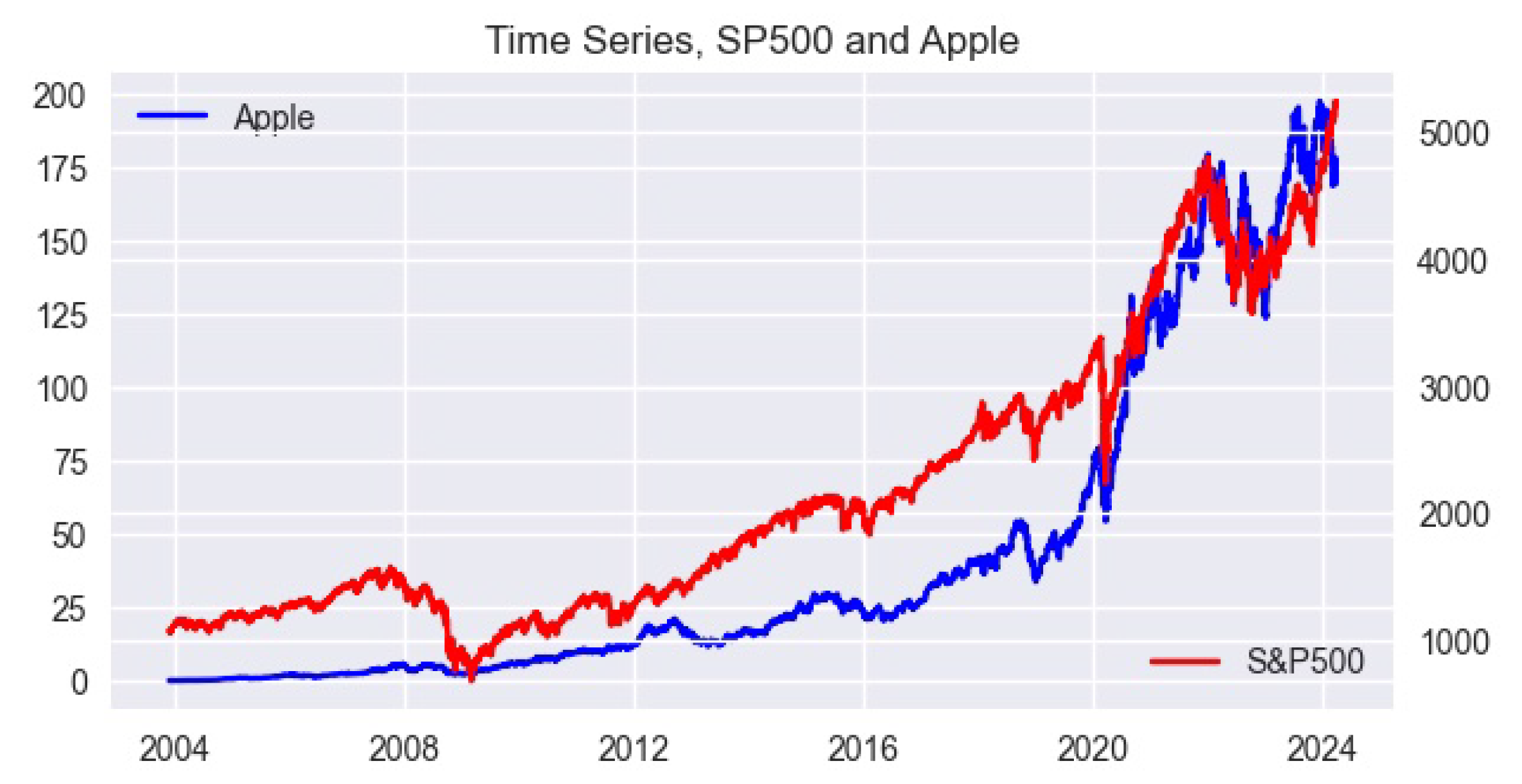
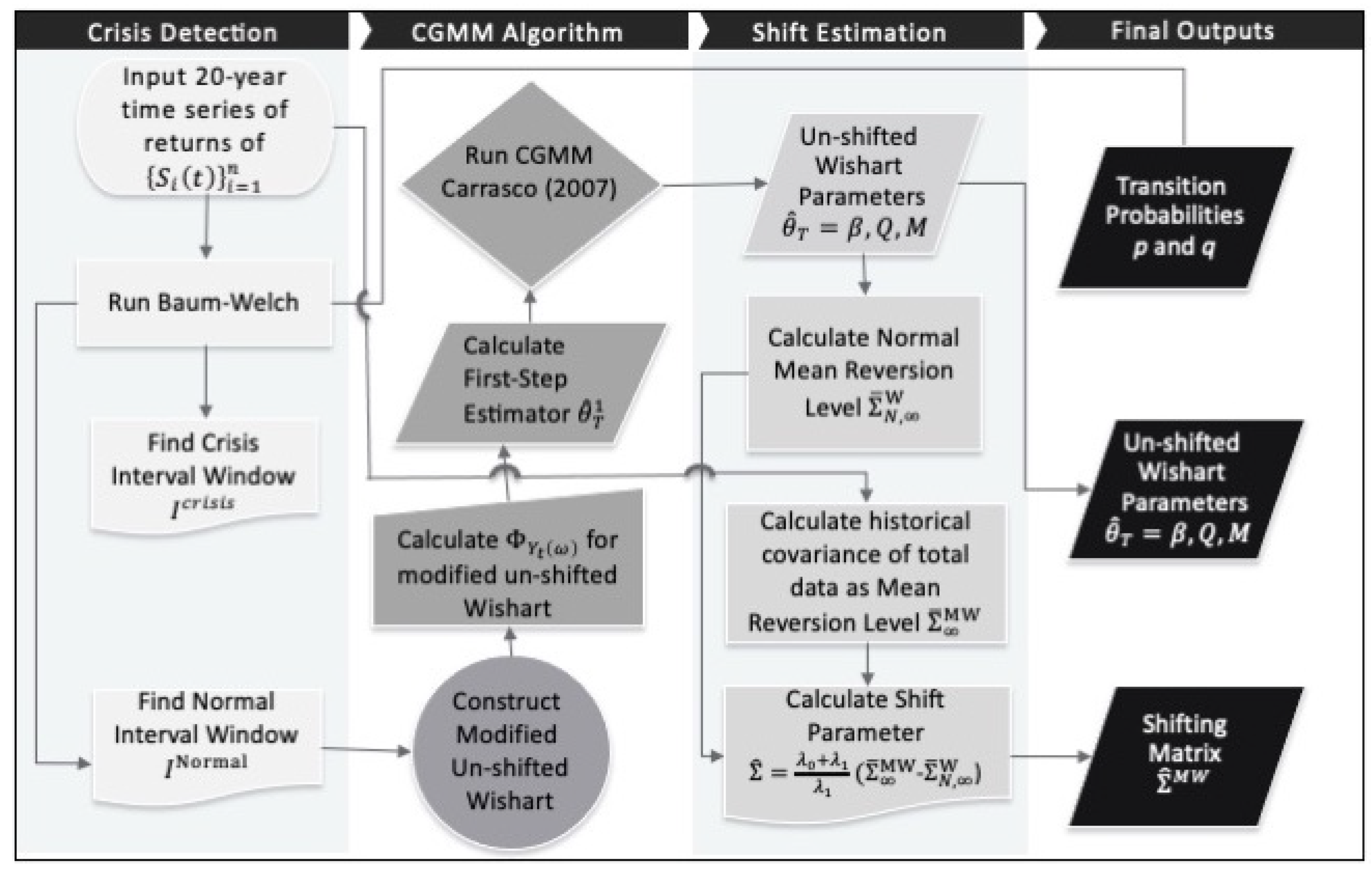
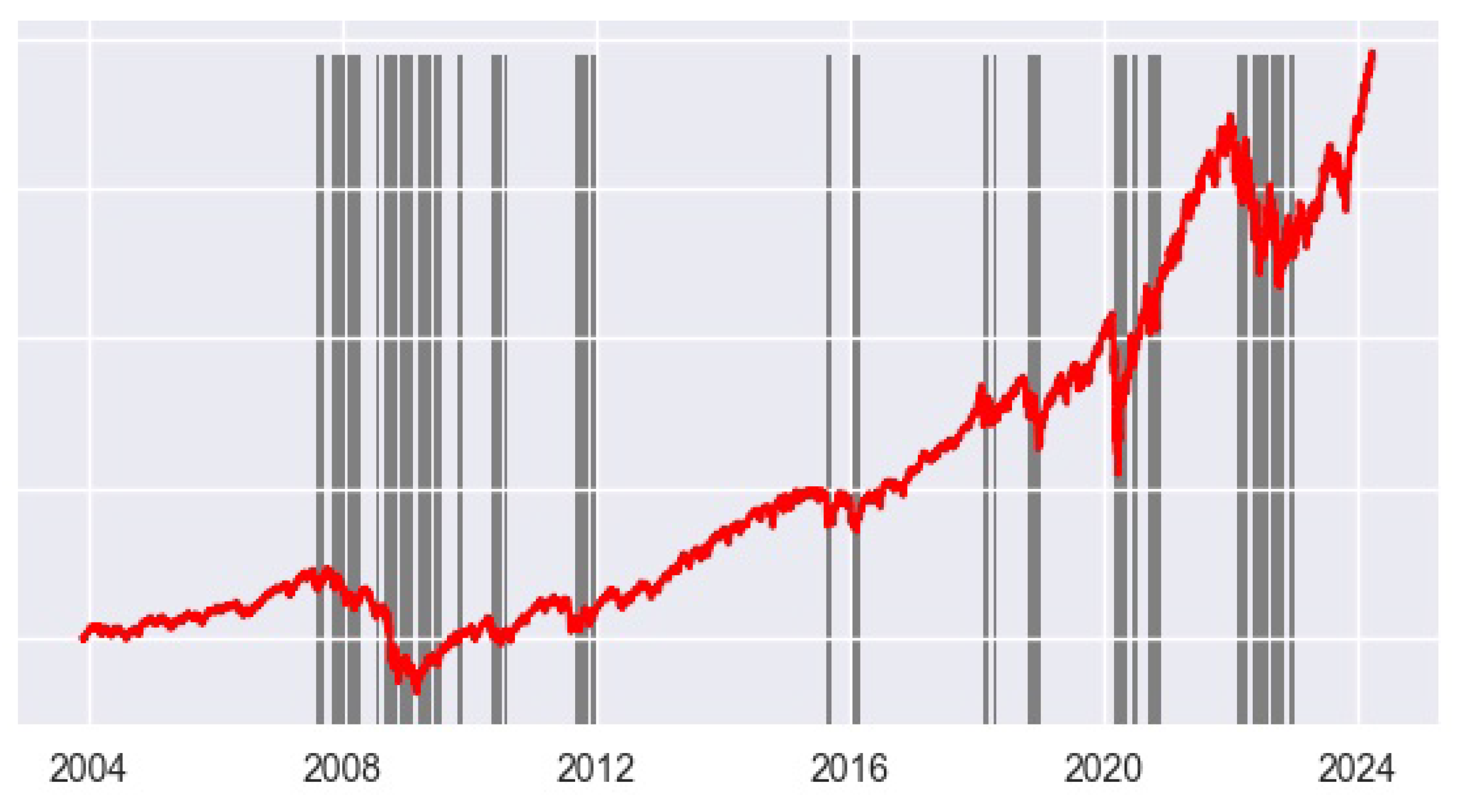
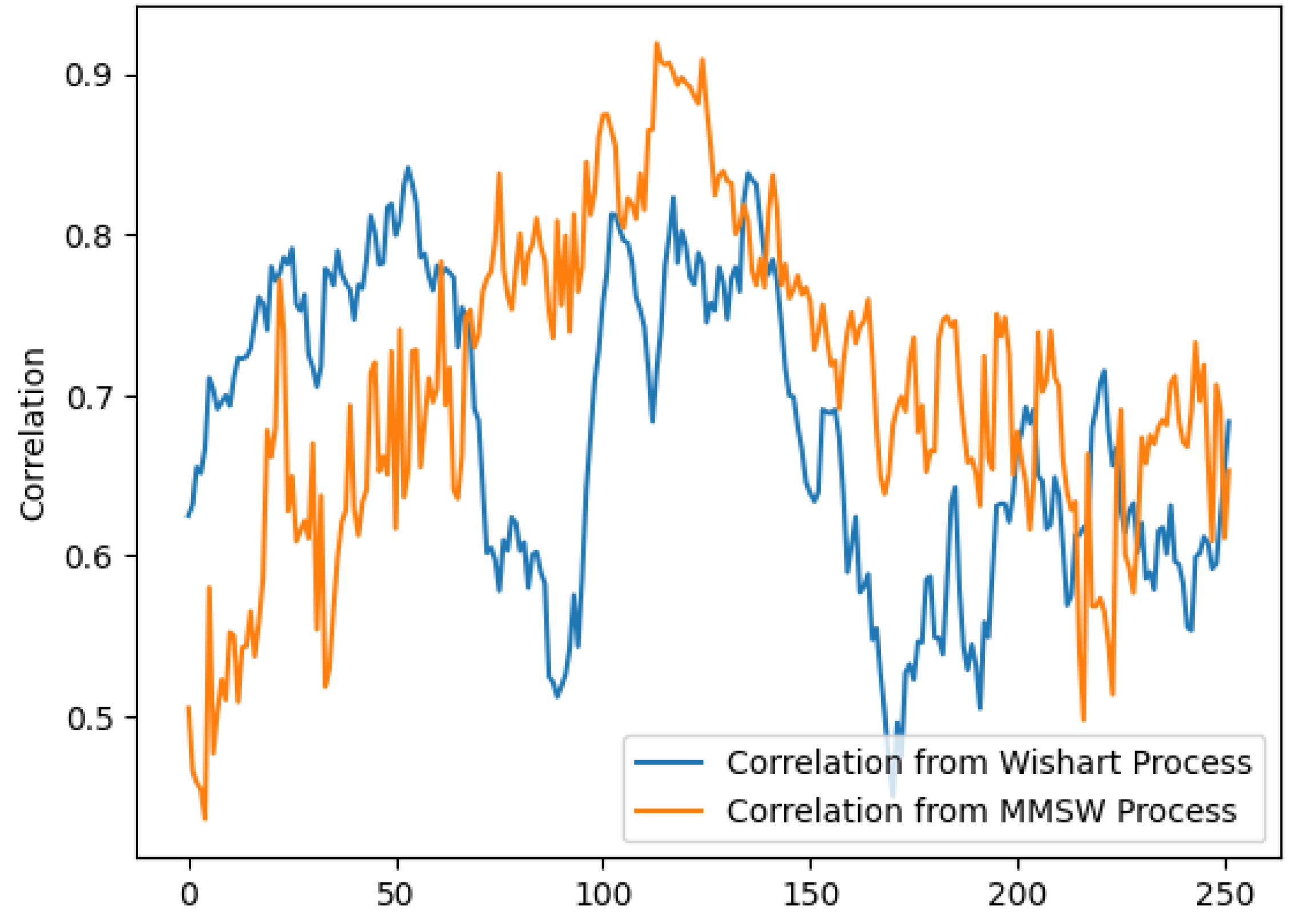
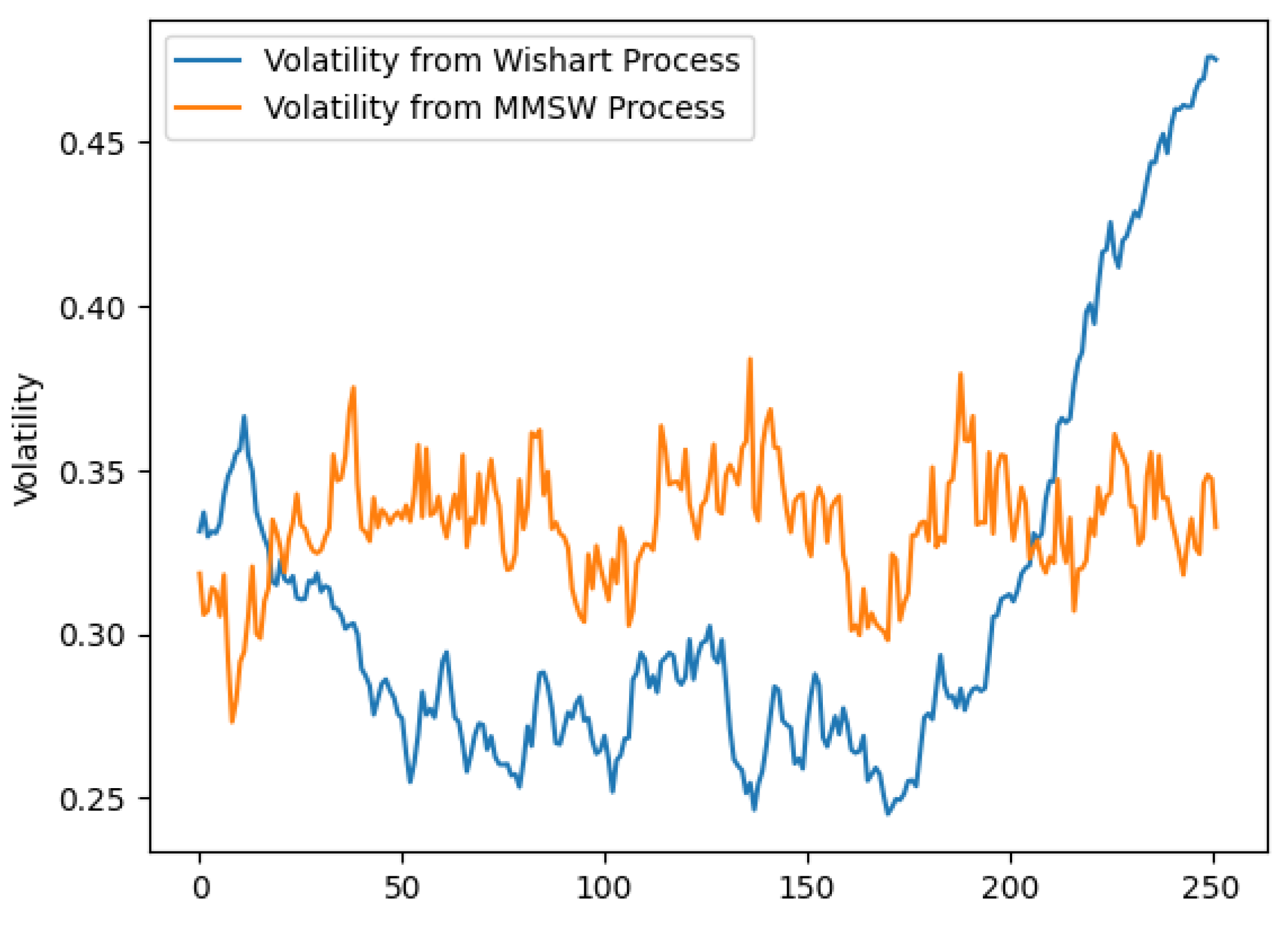
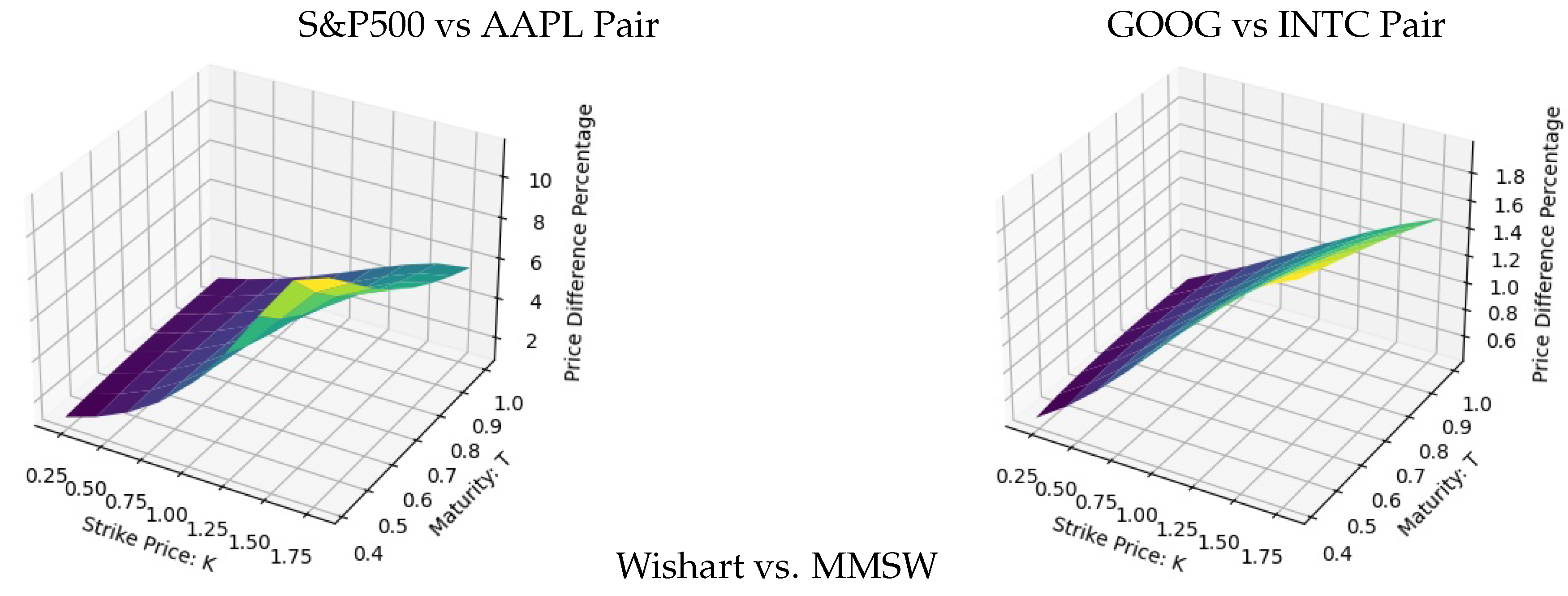
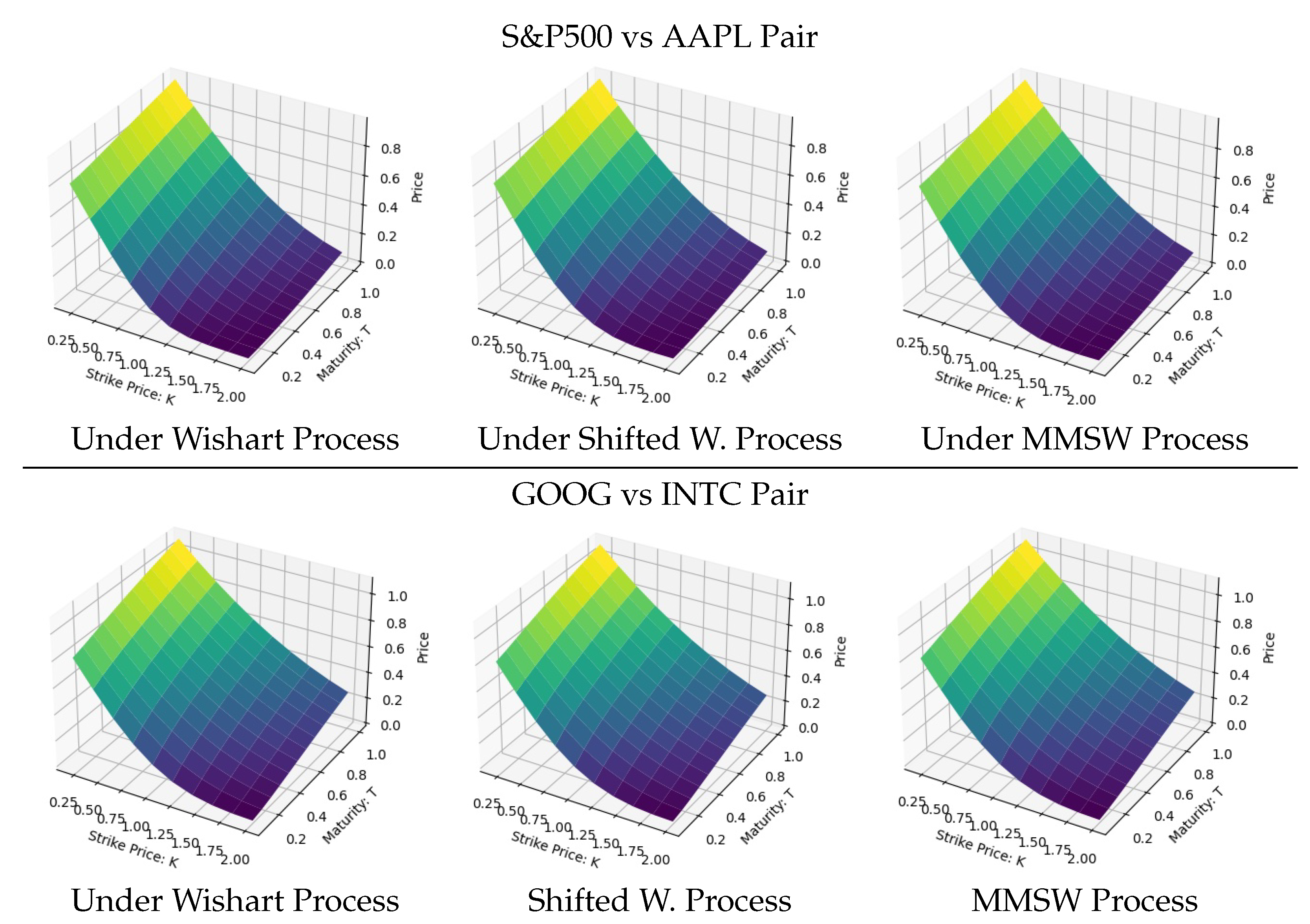
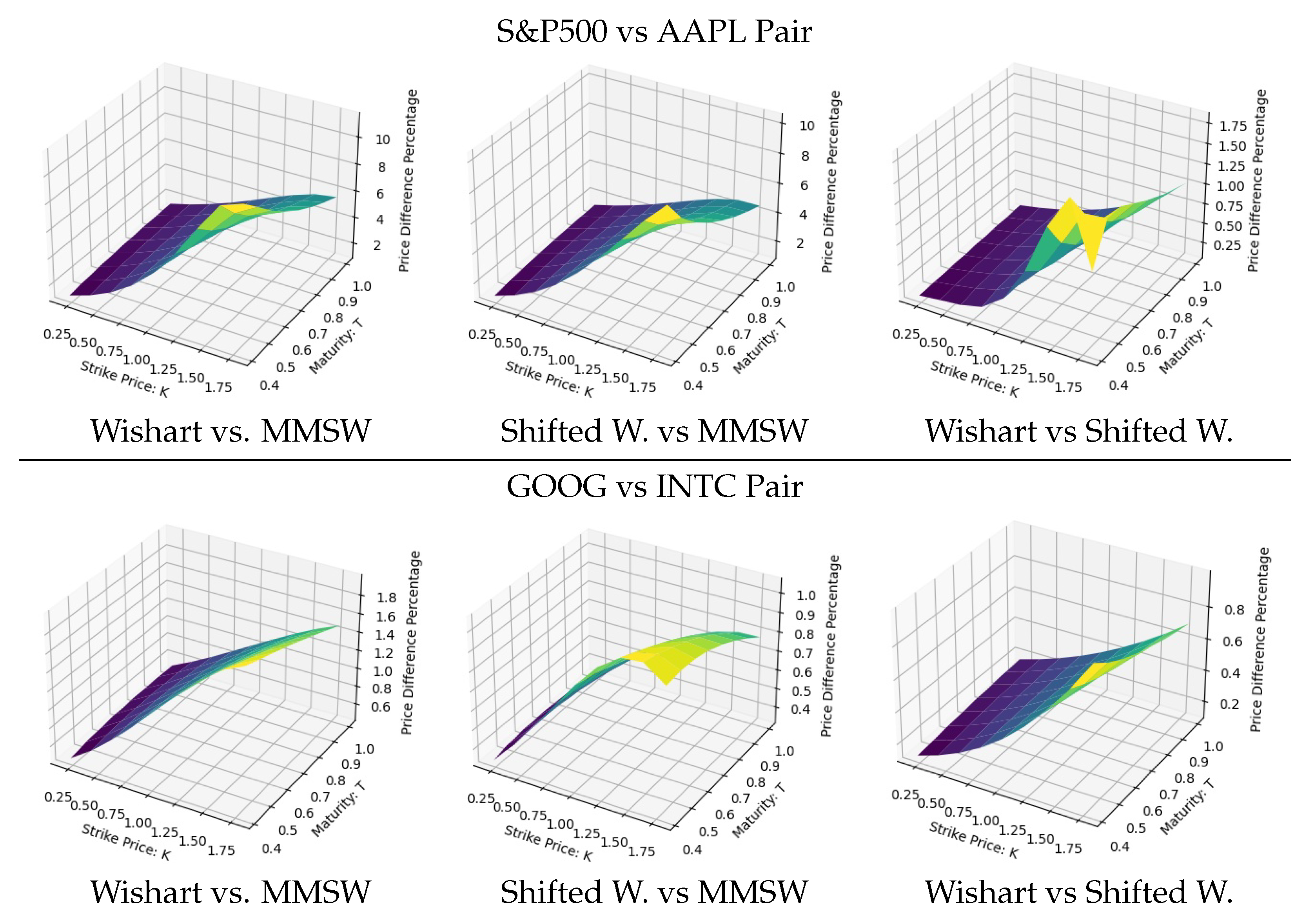
| Parameters | Wishart | MMSW | Wishart | MMSW | |||||
|---|---|---|---|---|---|---|---|---|---|
| S&P500–AAPL | S&P500–AAPL | GOOG–INTC | GOOG–INTC | ||||||
| −1.003 | 0.202 | −1.020 | 0.142 | −0.999 | −0.443 | −1 | −0.839 | ||
| 1.559 | −1 | 1.360 | −0.822 | 1.444 | −1 | 1.722 | −1 | ||
| 0.077 | 0 | 0.069 | 0 | 0.149 | 0 | 0.152 | 0 | ||
| −0.020 | 0.011 | −0.018 | 0.013 | 0 | 0.099 | 0 | 0.092 | ||
| 9.732 | 7.550 | 9.911 | 9.935 | ||||||
| −0.505 | −0.550 | −0.386 | −0.408 | ||||||
| −0.217 | −0.193 | −0.187 | −0.127 | ||||||
| 0.037 | 0.040 | 0.021 | 0.023 | 0.092 | 0.042 | 0.087 | 0.033 | ||
| () | (0.627) | 0.110 | (0.499) | 0.101 | (0.419) | 0.109 | (0.355) | 0.099 | |
| 0.021 | 0.021 | 0.007 | 0.012 | ||||||
| 0.021 | 0.012 | 0.012 | 0.015 | ||||||
| 0.041 | 0.045 | 0.094 | 0.045 | ||||||
| (0.661) | 0.113 | (0.434) | 0.114 | ||||||
| p | 0.779 | 1.066 | 0.745 | 44.003 | |||||
| 3.765 | 128.68 | ||||||||
| s.e. | 0.009 | 0.008 | |||||||
| s.e. | 0.025 | 0.122 | |||||||
| Option | K | Source of Price | Wishart | Shifted W. | MMSW |
|---|---|---|---|---|---|
| Formula | 0.7454 | 0.7470 | 0.7617 | ||
| In The Money | 0.5 | Monte Carlo | 0.7487 | 0.7368 | 0.7470 |
| MC 95% lower bound | 0.7288 | 0.7168 | 0.7269 | ||
| MC 95% upper bound | 0.7686 | 0.7568 | 0.7671 | ||
| Formula | 0.4339 | 0.4357 | 0.4498 | ||
| At The Money | 1 | Monte Carlo | 0.4369 | 0.4309 | 0.4390 |
| MC 95% lower bound | 0.4212 | 0.4151 | 0.4231 | ||
| MC 95% upper bound | 0.4526 | 0.4466 | 0.4549 | ||
| Formula | 0.2124 | 0.2140 | 0.2236 | ||
| Out of The Money | 1.5 | Monte Carlo | 0.2142 | 0.2127 | 0.2184 |
| MC 95% lower bound | 0.2031 | 0.2016 | 0.2072 | ||
| MC 95% upper bound | 0.2253 | 0.2239 | 0.2297 |
| Option | K | Source of Price | Wishart | Shifted W. | MMSW |
|---|---|---|---|---|---|
| Formula | 0.9030 | 0.9052 | 0.9093 | ||
| In The Money | 0.5 | Monte Carlo | 0.8895 | 0.9010 | 0.9263 |
| MC 95% lower bound | 0.8594 | 0.8701 | 0.8957 | ||
| MC 95% upper bound | 0.9195 | 0.9318 | 0.9569 | ||
| Formula | 0.6275 | 0.6298 | 0.6339 | ||
| At The Money | 1 | Monte Carlo | 0.6129 | 0.6268 | 0.6472 |
| MC 95% lower bound | 0.5870 | 0.6001 | 0.6208 | ||
| MC 95% upper bound | 0.6388 | 0.6535 | 0.6736 | ||
| Formula | 0.4158 | 0.4182 | 0.4214 | ||
| Out of The Money | 1.5 | Monte Carlo | 0.4022 | 0.4160 | 0.4308 |
| MC 95% lower bound | 0.3807 | 0.3936 | 0.4088 | ||
| MC 95% upper bound | 0.4237 | 0.4384 | 0.4527 |
Disclaimer/Publisher’s Note: The statements, opinions and data contained in all publications are solely those of the individual author(s) and contributor(s) and not of MDPI and/or the editor(s). MDPI and/or the editor(s) disclaim responsibility for any injury to people or property resulting from any ideas, methods, instructions or products referred to in the content. |
© 2025 by the authors. Licensee MDPI, Basel, Switzerland. This article is an open access article distributed under the terms and conditions of the Creative Commons Attribution (CC BY) license (https://creativecommons.org/licenses/by/4.0/).
Share and Cite
Faraz, B.-H.A.; Arian, H.; Escobar-Anel, M. Markov-Modulated and Shifted Wishart Processes with Applications in Derivatives Pricing. Int. J. Financial Stud. 2025, 13, 91. https://doi.org/10.3390/ijfs13020091
Faraz B-HA, Arian H, Escobar-Anel M. Markov-Modulated and Shifted Wishart Processes with Applications in Derivatives Pricing. International Journal of Financial Studies. 2025; 13(2):91. https://doi.org/10.3390/ijfs13020091
Chicago/Turabian StyleFaraz, Behzad-Hussein Azadie, Hamid Arian, and Marcos Escobar-Anel. 2025. "Markov-Modulated and Shifted Wishart Processes with Applications in Derivatives Pricing" International Journal of Financial Studies 13, no. 2: 91. https://doi.org/10.3390/ijfs13020091
APA StyleFaraz, B.-H. A., Arian, H., & Escobar-Anel, M. (2025). Markov-Modulated and Shifted Wishart Processes with Applications in Derivatives Pricing. International Journal of Financial Studies, 13(2), 91. https://doi.org/10.3390/ijfs13020091






